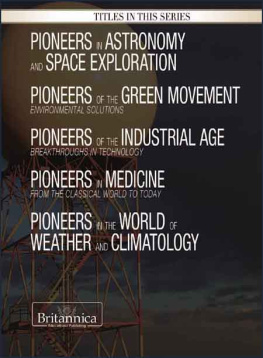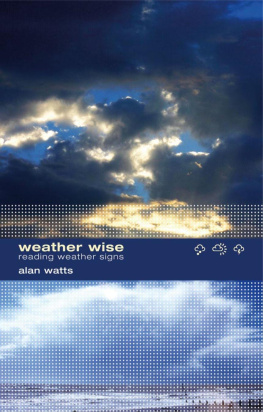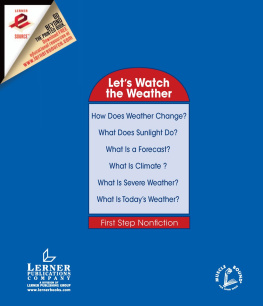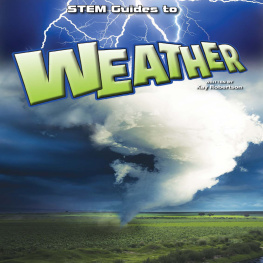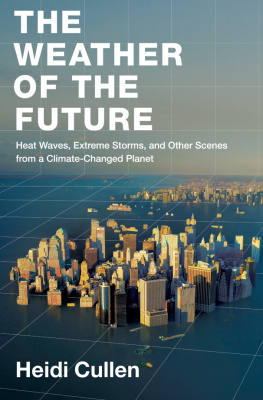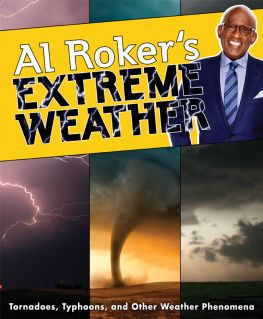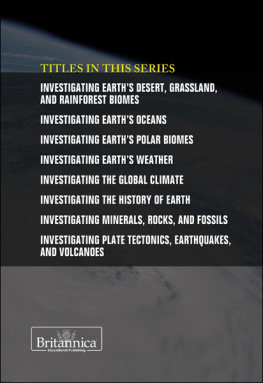PIONEERS IN THE WORLD OF WEATHER AND CLIMATOLOGY
INVENTORS AND INNOVATORS
PIONEERS IN THE WORLD OF WEATHER AND CLIMATOLOGY
EDITED BY SHERMAN HOLLAR

Published in 2013 by Britannica Educational Publishing
(a trademark of Encyclopdia Britannica, Inc.)
in association with Rosen Educational Services, LLC
29 East 21st Street, New York, NY 10010.
Copyright 2013 Encyclopdia Britannica, Inc. Britannica, Encyclopdia Britannica, and the Thistle logo are registered trademarks of Encyclopdia Britannica, Inc. All rights reserved.
Rosen Educational Services materials copyright 2013 Rosen Educational Services, LLC. All rights reserved.
Distributed exclusively by Rosen Educational Services.
For a listing of additional Britannica Educational Publishing titles, call toll free (800) 237-9932.
First Edition
Britannica Educational Publishing
J.E. Luebering: Director, Core Reference Group, Encyclopdia Britannica
Adam Augustyn: Assistant Manager, Encyclopdia Britannica
Anthony L. Green: Editor, Comptons by Britannica
Michael Anderson: Senior Editor, Comptons by Britannica
Andrea R. Field: Senior Editor, Comptons by Britannica
Sherman Hollar: Senior Editor, Comptons by Britannica
Marilyn L. Barton: Senior Coordinator, Production Control
Steven Bosco: Director, Editorial Technologies
Lisa S. Braucher: Senior Producer and Data Editor
Yvette Charboneau: Senior Copy Editor
Kathy Nakamura: Manager, Media Acquisition
Rosen Educational Services
Jeanne Nagle: Senior Editor
Nelson S: Art Director
Cindy Reiman: Photography Manager
Karen Huang: Photo Researcher
Brian Garvey: Designer, Cover Design
Introduction by Jeanne Nagle
Library of Congress Cataloging-in-Publication Data
Pioneers in the world of weather and climatology/edited by Sherman Hollar.1st ed.
p. cm.(Inventors and innovators)
In association with Britannica Edicational Publishing, Rosen Educational Services.
Includes bibliographical references and index.
Audience: 7 to 8.
ISBN 978-1-61530-743-2 (eBook)
1. MeteorologistsBiographyJuvenile literature. 2. ClimatologistsBiographyJuvenile literature. 3. MeteorologyHistoryJuvenile literature. 4. ClimatologyHistoryJuvenile literature.
I. Hollar, Sherman.
QC858.A2P56 2013
511.60922dc23
2012008580
On the cover, p.3: A Doppler radar tower stands in relief of an approaching storm. Dean Kerr/Shutterstock.com
Interior background image (veins of lightning) iStockphoto.com/Tatjana Rittner
CONTENTS
INTRODUCTION

A nyone who has ever planned an outdoor event, dressed in layers to accommodate seasonal temperature changes, or wondered whether he or she should grab an umbrella on the way out the door knows that the weather can be unpredictable. Throughout history, many scientific minds have risen to the challenge of understanding and explaining the natural phenomena of storms, weather fronts, and climatic changes. It is these pioneering individuals whom this book celebrates.
Early weather-related scientific discoveries often came about as the result of exploration of other matters. The ancient Greek philosopher Aristotle wrote the Meteorologica, a famous essay on meteorology, while studying the natural world and pondering the universe. Galileo, who is most famous for his work in astronomy, invented the thermometer while teaching physics at the University of Padua. Neither Daniel Fahrenheit nor Anders Celsius had studying the weather as their main goal, yet each had a temperature scale he had devised named after him.
There also were renaissance men such as Benjamin Franklin and Joseph Henry, who were accomplished in many fields. Meteorology was just one of many areas in which they made a mark. Their contributions to the atmospheric sciences are well-documented, especially Franklins famous experiment with a kite flown during a thunderstorm to test the electrical properties of lightning.
Yet several of the pioneers featured in this book have dedicated their professional lives specifically to the study of weather and climate. These are the people who have conducted the research and created the tools that have advanced the fields of meteorology and climatology. Among their number is Wladimir Kppen, whose charting of world temperatures led him to divide the world into climate regionsa landmark event in climatology.
It could be said that other weather and climate pioneers had their heads in the clouds, in the best possible sense. Swedish meteorologist Tor Bergeron was known for his work in cloud physics, specifically regarding the question of how precipitation occurs. American Vincent Joseph Schaefer was not merely content to study clouds. Instead, he sought to control their output. In 1946 Schaefer conducted the first successful cloud seeding, which involves treating clouds with chemicals to produce snow or rain.
Humankinds influence on the weather didnt end there. By the middle of the 20th century, scientists were beginning to understand that changes in climate were linked to human activity such as the burning of fossil fuels. In 1958, climatologist Charles David Keeling began measuring carbon dioxide levels near an inactive Hawaiian volcano. His findings showed that CO2 levels were rising, which scientists claim is one cause of global warming. As chairman of the United Nations Intergovernmental Panel on Climate Change (IPCC), Swedish meteorologist Bert Bolin helped raise awareness of the dangers of climate change. In 2007 the IPCC shared a Nobel Peace Prize with former U.S. vice president Al Gore.
It is unlikely that anyone will ever be able to predict the weather with 100 percent accuracy. But thanks to the efforts of these pioneers and others like them, there are far fewer mysteries in the worlds of meteorology and climatology than there once were.
CHAPTER 1
ARISTOTLE
T he ancient Greek philosopher Aristotle, one of the greatest thinkers of all time, wrote the worlds first meteorological treatise, Meteorologica, in the 4th century BC. Meteorologica remained the standard work on the subject for 2,000 years.
Born in 384 BC in Stagira, on the northwest coast of the Aegean Sea, Aristotle was the son of the physician who tended to the king of Macedonia. As such, the boy spent plenty of time at court. At 17, Aristotle enrolled at the famous Academy, directed by the philosopher Plato.
Aristotle threw himself wholeheartedly into Platos pursuit of truth and goodness. Plato was soon calling him the mind of the school. Aristotle stayed at the Academy for 20 years, leaving only when his beloved master died in 347 BC. In later years he renounced some of Platos theories and went far beyond him in breadth of knowledge.

A statue of the philosopher Aristotle in his Grecian birthplace. His Meteorologica set the standard in meteorology for 2,000 years. Panos Karapanagiotis/Shutterstock.com
After leaving the Academy, Aristotle taught school on the coast of Asia Minor, and spent two years studying marine biology on the Greek island of Lesbos. In 342 BC, he returned to Macedonia, at the invitation of Philip II, to teach the kings young son, Alexanderwho would later become Alexander the Great. No one knows how much influence the philosopher had on the headstrong youth, but after he became king, Alexander gave Aristotle enough money to set up a school in Athens.
Next page
